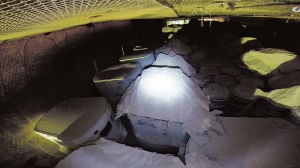

 Follow us
Follow us |
 |
 Follow us Follow us |
|
| "Remember Your Humanity" blog |
Emails: LANL ignored warnings about chemical mix
Toxic waste from Los Alamos National Laboratory stacked in Panel 7 at the Wast Isolation Pilot Plant in Carlsbad, shown May 10, is damaged after what some experts believe was a chemical reaction in a drum mixed with an absorbent substance similar to kitty litter. The state Environment Department released documents this week showing that another substance could have caused the breach, which may have caused a radiation release that has indefinitely shuttered the nuclear waste dump. Courtesy the New Mexico Environment Department Posted: Thursday, May 29, 2014 8:00 pm | Updated: 10:56 am, Fri May 30, 2014. By Patrick Malone Los Alamos National Laboratory last year gave a federal contractor permission to switch the neutralizing agents it mixed with nuclear waste before shipment to the Waste Isolation Pilot Plant near Carlsbad for underground storage. The request came despite explicit warnings from the manufacturer that its product to neutralize pH levels is chemically incompatible with metallic nitrates and strong oxidizers. The waste, a legacy from decades of nuclear weapons research at LANL, fit both of those descriptions. Nonetheless, the lab approved the change to the new neutralizer, according to documents made public this week by the New Mexico Environment Department. The documents raise new questions about oversight of the nuclear waste shipments as federal investigators continue to look into what caused a radiation leak in February that shut down WIPP. Outside chemists say the substance that the contractor, EnergySolutions, chose to mix with the radioactive waste easily should have been identified as potentially volatile. The contractor even included the manufacturer’s warnings about the chemicals in its 2013 requests to LANL for the change. Jim Conca, a geochemist who worked at LANL for years, said the documents indicate LANL did not thoroughly vet EnergySolutions’ request to change neutralizers by consulting first with the lab’s chemists. “When you get down to it, it went up the chain to the wrong person,” he said. “Any change at all like this has to go through someone who knows this waste very well.” Conca was the first to publicly announce the theory that a switch from clay-based kitty litter as an absorbent in the packaged waste to an organic kitty litter could be responsible for the chemical reaction that blew open a drum of LANL waste at WIPP and caused the radiation leak. The revelations contained in the documents — that other incompatible substances were mixed with the waste — didn’t change Conca’s mind. “Of course this waste is a strong oxidizer. This is a classic case of not following directions or even following the vendor’s instructions,” he said. “Had the correct kitty litter been used, it would have been all right. This is a LANL problem and a contractor problem.” LANL spokesman Matt Nerzig said, “We’re looking into all possible causes — including the contents of the drums, and will continue to do so until we are satisfied that we know what caused the radiological release.” New Mexico Environment Department spokesman Jim Winchester said, “The kitty litter change is still one of the factors being considered.” Among the documents released by the New Mexico Environment Department were a chain of emails exchanged last summer between Zeke Wilmot, an industrial hygienist for EnergySolutions, and Andrew Ezell, a subcontract technical representative for LANL. Wilmot requested approval to use liquid acid and base neutralizers to make it easier to test the pH of the waste. He recommended that LANL’s experts on chemical compatibility review the request, which was submitted complete with manufacturers’ warnings about incompatible chemicals. “As the water reactivity of plutonium and criticality safety issues are not my area of expertise it may be advisable to have LANL personnel weigh in on these issues as well,” Wilmot wrote. Ezell approved the request on behalf of LANL. “I still find it hard to believe that some of the chemists at Los Alamos weren’t aware that there hadn’t been some testing to determine this is OK or not OK,” said Don Hancock, administrator of the nuclear waste watchdog organization Southwest Research and Information Center. The head of another watchdog group, Greg Mello, executive director of Los Alamos Study Group, said the revelations in the document are a testament to the breakdown in oversight of a segment of the government that has become largely privatized. He blamed Los Alamos National Security LLC, which manages and operates LANL, for the lapse in scrutiny. “LANS needs to step up and say, ‘We screwed up. We should have supervised this better,’ ” Mello said. On Thursday, the New Mexico Environment Department, the permitting agency with regulatory oversight authority for LANL and WIPP, announced it had approved a safety plan submitted last week by LANL that outlines the lab’s plans for guarding against leaks from nuclear waste containers housed on-site at Los Alamos. Among them are 57 barrels of waste treated with the organic kitty litter. The plan calls for isolating, securing and monitoring containers of waste, and treating some of them. The Environment Department approved the plan with certain conditions, primarily involving reporting to the state about environmental quality measurements and how workers would be protected from coming in contact with contamination. The Environment Department has imposed a Friday deadline for WIPP to submit its plan for securing the area where the waste barrel suspected of causing the radiation leak is housed. Conca and Hancock disagree over what the safety plan should entail. Conca contends fortifying the area within WIPP with adequate bulkheads and sealing it would be sufficient to contain the threat of further contamination. Hancock said more “robust barriers” would be his preference. Contact Patrick Malone at 986-3017 or pmalone@sfnewmexican.com. Follow him on Twitter @pmalonenm. |
|||
|
|
|||
|